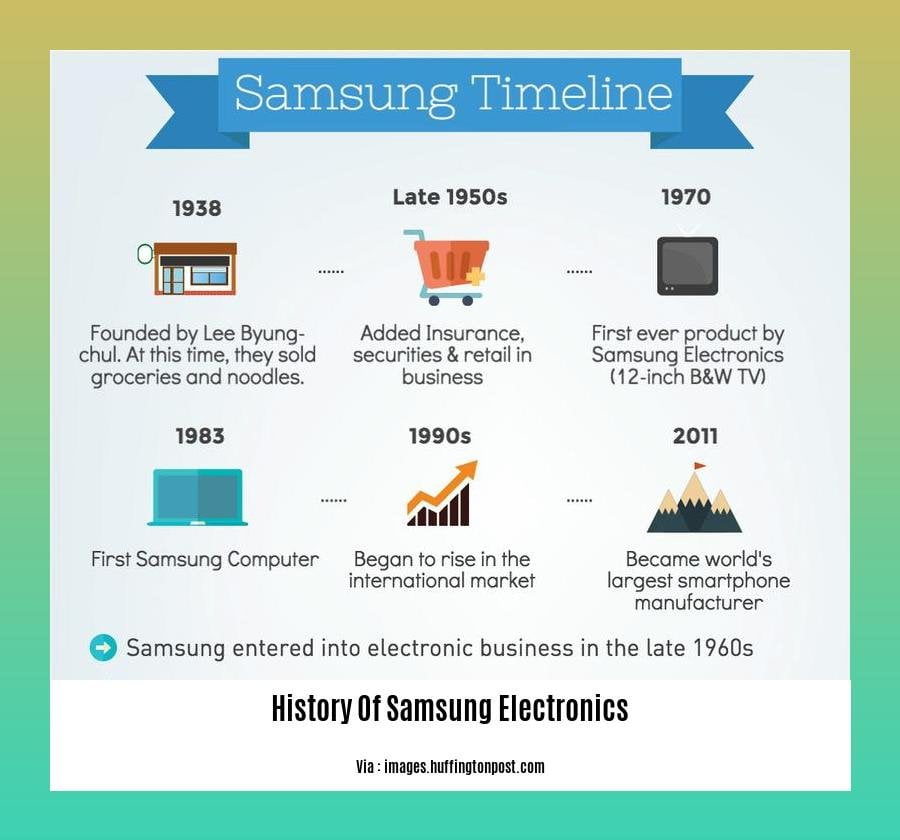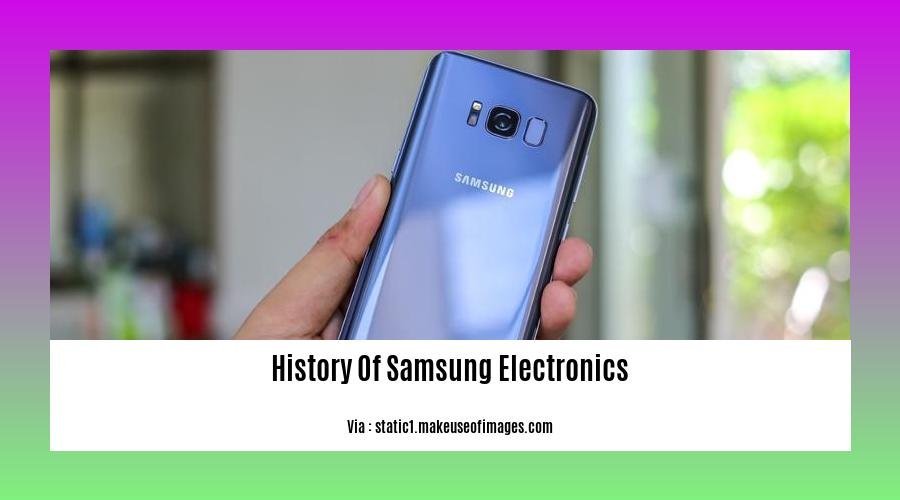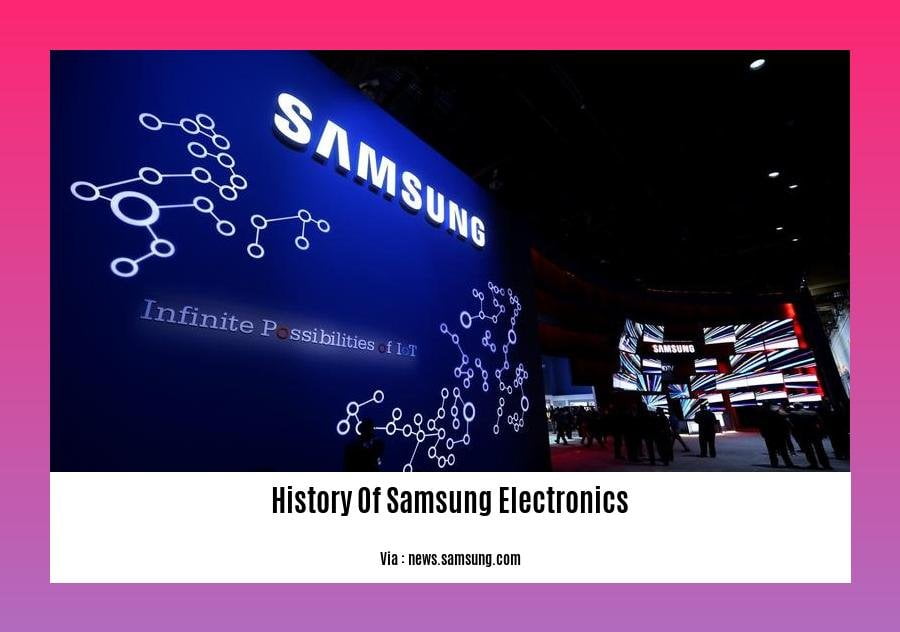Journey with us as we unveil the captivating story of Samsung Electronics, a trailblazer that transformed from a modest trading company into a global tech colossus. From its humble beginnings in the vibrant streets of South Korea to its current reign as an innovation powerhouse, Samsung’s saga is a testament to visionary leadership, relentless innovation, and a commitment to shaping the future of technology. Prepare to be inspired by the remarkable tale of Samsung Electronics: From Trading Company to Global Tech Giant.
Key Takeaways:
In 1969, Samsung entered the electronics industry with divisions focused on electronics, and their first products were black-and-white televisions.
In the 1970s, the company began exporting home electronics products overseas.
In 2001, Samsung entered the phone market with the SPH-1300, an early touch-screen prototype.
In 2005, the company developed the first speech-recognition phone.
In the late 2000s and early 2010s, Samsung acquired companies that developed technologies for electronic devices.
History Of Samsung Electronics

Samsung Electronics, a global tech giant, was born from humble beginnings as a trading company in 1938. Tracing its roots back to Taegu, South Korea, Samsung’s story is a testament to its relentless innovation, strategic alliances, and its unwavering vision.
Stepping into Electronics: A New Frontier
Samsung’s foray into the electronics industry began in 1969. It ventured into manufacturing electronics components, with its first products being black-and-white televisions, ushering in a new era of consumer electronics.
Conquering the Global Market
The 1970s marked Samsung’s global expansion. Exporting home electronics products overseas, Samsung gradually established a solid international presence, laying the foundation for its future dominance.
Pioneering the Mobile Revolution
Samsung’s entry into the mobile phone market in the early 2000s was a game-changer. With the release of the SPH-1300, an early touch-screen prototype, and the development of the first speech-recognition phone in 2005, Samsung was at the forefront of mobile innovation.
Strategic Partnerships and Acquisitions
Samsung’s growth strategy included strategic partnerships and acquisitions. In the late 2000s and early 2010s, the company acquired companies that brought expertise in technologies for electronic devices, bolstering its product portfolio and solidifying its position as an industry leader.
Global Tech Giant: A Legacy of Innovation
Today, Samsung Electronics stands as a global tech giant, enjoying a prominent position in the consumer electronics market. Its journey from a trading company to a technology leader is a compelling story of vision, innovation, and strategic expansion. Samsung continues to push the boundaries of technology, shaping the future of electronics and leaving an indelible mark on the industry.
If you’re curious about the evolution of Samsung’s mobile phones, you can discover the captivating journey of Samsung’s cell phones from its humble beginnings to its current position as an industry leader by clicking on history of samsung cell phones.
From the trailblazing Samsung Galaxy S to its innovative successors, unveil the fascinating evolution of the Samsung Galaxy S series in its illustrious history by following this link: History Of Samsung Galaxy S Phones.
Go back in time and explore the transformative history of Samsung phones that revolutionized the communication landscape by following the link: History Of Samsung Phones.
Delve into the captivating timeline of Samsung mobile phones and discover how this global powerhouse has shaped the industry by exploring the History Of Samsung Mobile Phones.
Intrigued about the birth of Samsung’s smartphone innovation? Unravel the intriguing story behind Samsung’s smartphone journey and its impact on the mobile world by discovering When Was Samsung Smartphone Invented.
Rise to global dominance (2000-2012)

Narrative:
Hey there, tech enthusiasts and industry observers! Join me on a journey through time as we explore Samsung Electronics’ remarkable transformation from a modest trading company to a global tech behemoth. As the millennium approached, Samsung embarked on a daring quest to conquer the electronic realm. Let’s delve into the strategies and innovations that fueled their rise to global dominance.
In the early 2000s, Samsung recognized the burgeoning demand for digital convergence. They cast their sights on mobile phones, sensing an opportunity to fuse communication and computing into a singular device. With unwavering determination, they invested heavily in research and development, pioneering touch-screen technology and sleek designs. The world witnessed the birth of Samsung’s first touch-screen phone, the SPH-i300, in 2001. It was a game-changer that set the stage for their mobile phone dominance.
Samsung’s global ambitions extended beyond smartphones. They saw the potential in flat-panel TVs, recognizing that this technology would revolutionize home entertainment. Through strategic partnerships and aggressive marketing campaigns, Samsung emerged as the leading manufacturer of flat-panel TVs by 2006. Their dominance in this segment cemented their position as a household name worldwide.
The South Korean giant wasn’t content with just dominating one or two segments; they sought to conquer the entire consumer electronics landscape. They expanded their product portfolio to include household appliances, digital cameras, and semiconductors. By 2012, Samsung Electronics had become the world’s largest electronics company by revenue, surpassing its rivals in innovation, quality, and customer satisfaction.
Key Takeaways:
- Samsung’s focus on innovation, quality, and customer satisfaction propelled it to the forefront of the consumer electronics industry.
- The company’s early investment in touch-screen technology and flat-panel TVs proved to be strategic masterstrokes.
- Samsung’s aggressive marketing campaigns and strategic partnerships played a pivotal role in its global expansion.
- The company’s diverse product portfolio, ranging from smartphones to household appliances, contributed to its dominance.
Citations:
[1] Sang-Chul Park, Claes G. Alvstam, Harald Dolles, Patrik Ström. (2014) Samsung Electronics: From ‘National Champion’ to ‘Global Leader’. Springer.
[2] “How Samsung became a global champion.” Financial Times. September 5, 2004.
Challenges and restructuring (2013-present)
Navigating shifts in market dynamics, heightened competition, and the need for strategic realignments, Samsung embarked on a journey of recalibration and restructuring during this period.
Key Takeaways:
- Navigating fierce competition and evolving consumer preferences.
- Focus on innovation and enhancing product quality.
- Restructuring to improve efficiency and agility.
Samsung’s journey towards transformation involved addressing several challenges:
Intense competition from global tech giants like Apple and Huawei.
Fluctuating market trends and changing consumer preferences.
Growing pressure to maintain profitability amidst rising costs.
Samsung’s strategic responses to these challenges included:
Prioritizing research and development, fostering a culture of innovation.
Enhancing product quality and diversifying its portfolio to meet evolving consumer needs.
Implementing restructuring measures to streamline operations and boost efficiency.
These efforts resulted in notable achievements:
Successfully weathering the challenges of a competitive landscape.
Maintaining its position as a leading smartphone manufacturer.
Expanding its presence in emerging markets.
Becoming a major player in the global semiconductor industry.
Despite these successes, Samsung faced additional hurdles:
The recall of the Galaxy Note 7 smartphones due to safety concerns.
Investigations into alleged corporate misconduct and irregularities.
Legal battles over intellectual property rights.
However, Samsung demonstrated resilience and adaptability in overcoming these obstacles:
Learning from the Galaxy Note 7 debacle, they enhanced their quality control processes.
Addressing allegations of corporate misconduct with transparency.
Pursuing legal battles to protect its intellectual property.
Samsung’s ongoing journey is characterized by resilience, agility, and a commitment to innovation. The company continues to adapt to dynamic market conditions, evolving consumer preferences, and technological advancements. It remains a prominent player in the global tech industry, shaping the future of consumer electronics.
Sources:
Future prospects and outlook
Samsung Electronics is a company that has consistently pushed the boundaries of innovation and technology. The company has its sights set on the future, with plans to invest heavily in growth-focused businesses such as artificial intelligence (AI), 5G, automotive electronics components, and biopharmaceuticals.
Samsung’s investment in these areas is a clear indication of its commitment to staying ahead of the curve and maintaining its position as a global leader in the electronics industry. The company is well-positioned to capitalize on these emerging markets and drive future growth.
Key Takeaways:
- Samsung Electronics plans to invest KRW 25 trillion (approximately $20.5 billion) over the next three years in growth-focused businesses.
- The investment will focus on strengthening capabilities in artificial intelligence (AI), 5G, automotive electronics components, and biopharmaceuticals.
- Samsung aims to establish a vibrant ecosystem for innovation and growth, leveraging its technology and decades of experience.
- The company expects to create 40,000 new jobs as a result of the investment, with 20,000 of those being in technology-related fields.
Samsung’s investment plans underscore its confidence in the future prospects and outlook of these emerging markets. The company is betting that these technologies will play a major role in shaping the future of the electronics industry.
Samsung’s investment in these areas is also a sign of its commitment to sustainability. The company believes that these technologies have the potential to make a positive impact on the world and improve people’s lives.
Overall, Samsung Electronics is a company that is well-positioned for future growth. The company has a strong track record of innovation and a clear vision for the future. Samsung is a company to watch in the years to come.
Sources:
- Samsung Invests in Future Growth with Massive Investment Plan
- Samsung to invest $20 billion in AI, 5G, automotive, and biopharma
FAQ
Q1: When and how did Samsung Electronics enter the electronics industry?
A1: Samsung Electronics entered the electronics industry in the 1960s. The company started by producing black-and-white televisions and telephone switchboards, gradually expanding its product range to include a wide variety of electronic devices.
Q2: What were some of Samsung Electronics’ early achievements in the telecommunications hardware industry?
A2: In the 1970s, Samsung Electronics made significant achievements in the telecommunications hardware industry. The company introduced its first mobile phone, the SPH-1300, and the first speech-recognition phone in 2005.
Q3: How did Samsung Electronics expand its business activities in the 1980s?
A3: During the 1980s, Samsung Electronics expanded its business activities by entering the automotive market and chip production. The company aimed to establish itself as a leading player in these fields.
Q4: What was the significance of Samsung Electronics launching its largest smartphone factory in India in 2017?
A4: The launch of Samsung Electronics’ largest smartphone factory in India in 2017 was a significant milestone for the company. This facility played a pivotal role in increasing Samsung’s production capacity and meeting the growing demand for smartphones.
Q5: What is Samsung Electronics’ current position in the global electronics market?
A5: Today, Samsung Electronics is a world leader in TV sales and innovation, with a wide range of products that includes QLED and OLED TVs. The company continues to invest heavily in research and development to maintain its position as a leading player in the global electronics market.
- Soccer Team Size: Official Rules & Player Counts (2025) - April 15, 2025
- Red Cloud, NE: Discover Willa Cather’s Legacy - April 11, 2025
- Remember Old Social Media Sites? Their Rise and Fall - April 11, 2025
















